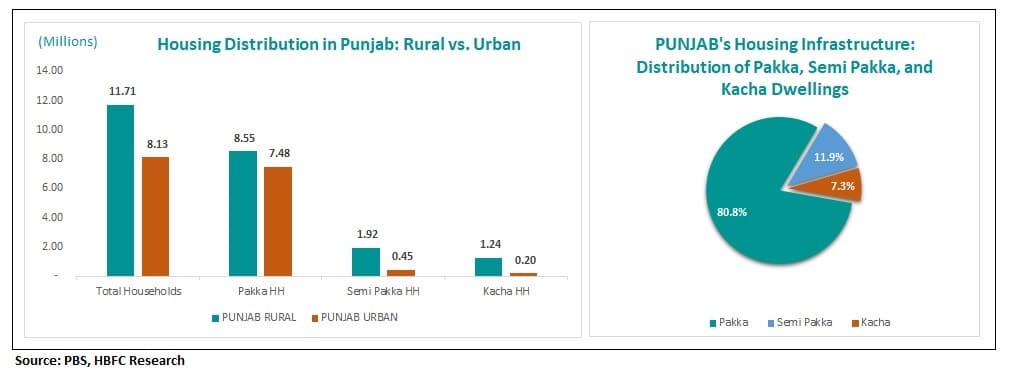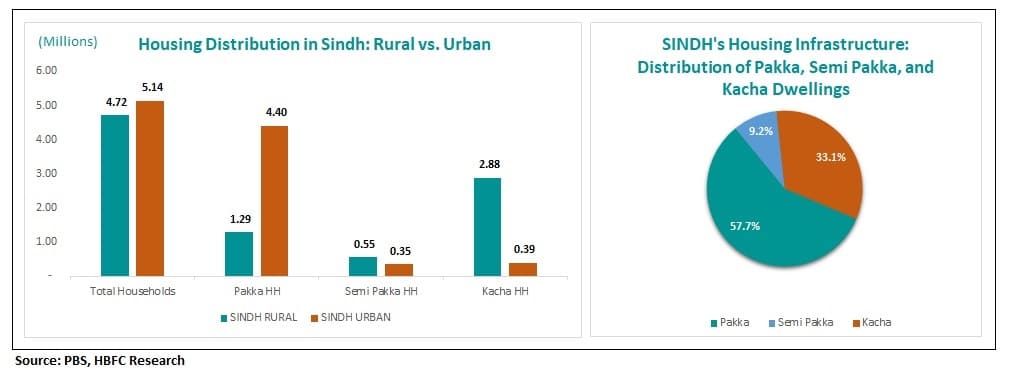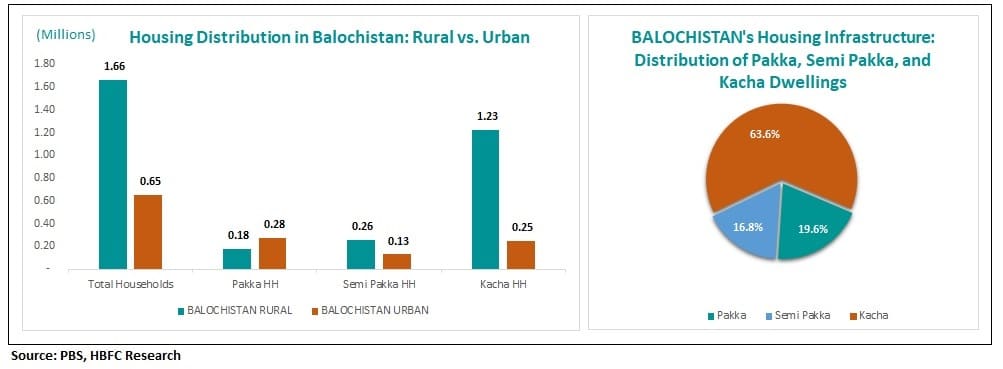The 2023 Census data on Pakistan’s housing reveals substantial disparities across the nation’s 38.29 million households, with 67.5% residing in pakka (permanent) structures, while the remaining 32.5% live in semi-pakka and kacha (temporary) dwellings. A significant urban-rural divide is evident, as 87.2% of urban households have pakka housing compared to only 54.7% in rural areas, highlighting a 32.5 percentage point differential. This gap reflects broader socioeconomic inequalities and varying levels of regional development, particularly in provinces like Balochistan and Khyber Pakhtunkhwa, where semi-pakka and kacha housing are more prevalent. The data underscores the urgent need for targeted policy interventions to address these housing deficits, promote balanced regional development, and reduce the underlying causes of this disparity.

KHYBER PAKHTUNKHWA
Khyber Pakhtunkhwa’s 5.86 million households exhibit a distinct housing distribution, with 55.6% living in pakka (permanent) structures, 19.6% in semi-pakka dwellings, and 24.8% in kacha (temporary) homes. The province has the highest proportion of semi-pakka housing among all provinces, suggesting a potential transitional phase in housing development. An urban-rural divide is evident, with 83.9% of urban households residing in pakka structures compared to just 50.3% in rural areas. This data points to the need for targeted interventions to enhance rural housing quality, facilitate the shift from semi-pakka to pakka structures, and address the socioeconomic factors driving these housing patterns.

PUNJAB
Punjab’s housing data, covering 19.84 million households, indicates superior housing quality relative to other provinces, with 80.8% of dwellings classified as pakka structures, 11.9% as semi-pakka, and only 7.3% as kacha homes. The urban-rural disparity is notably less pronounced, with 92.1% of urban and 73% of rural households residing in pakka structures. This relatively balanced distribution suggests more equitable development across Punjab, possibly reflecting effective regional planning or socioeconomic factors that have contributed to widespread housing improvements. The significant presence of pakka structures in rural areas is particularly noteworthy, calling for further exploration of the factors driving this trend and the potential lessons that can be applied to other provinces to enhance rural housing development.

SINDH
Sindh’s housing landscape, encompassing 9.86 million households, displays significant urban-rural disparities. While 57.7% of dwellings are pakka (permanent) structures, 9.2% are semi-pakka, and 33.1% are kacha (temporary) homes, the contrast between urban and rural areas is stark. In urban Sindh, 85.6% of households reside in pakka structures, compared to a mere 27.3% in rural areas, where a striking 61% of homes are kacha. This divergence highlights deep-rooted regional inequalities within the province, reflecting broader socioeconomic disparities between urban centers and rural regions. The prevalence of kacha housing in rural Sindh underscores an urgent need for targeted rural housing development initiatives and infrastructure investment to address these disparities and enhance living conditions across the province.

BALOCHISTAN
Balochistan’s housing data reveals significant challenges, with the province trailing behind others in housing quality. Of its 2.32 million households, only 19.6% live in pakka (permanent) structures, while 16.8% reside in semi-pakka homes, and a striking 63.6% are in kacha (temporary) dwellings. The situation is particularly concerning in urban areas, where 37.8% of houses are still kacha, indicating widespread infrastructure deficits. This suggests deeply entrenched developmental issues across the province, with the high proportion of kacha dwellings likely reflecting socioeconomic vulnerabilities such as poverty, limited access to resources, and slow economic development. The data underscores an urgent need for comprehensive and targeted interventions to enhance housing quality and improve living conditions throughout Balochistan.

ISLAMABAD CAPITAL TERRITORY
Islamabad Capital Territory’s housing data showcases exceptional housing quality, far surpassing all other regions in Pakistan. With 97.3% of its 0.41 million households classified as pakka (permanent) structures and only minimal proportions of semi-pakka (1.2%) and kacha (1.4%) dwellings, the territory exemplifies uniformly high housing standards. Remarkably, this quality extends even to rural areas, where 98.4% of households are pakka, effectively eliminating the urban-rural divide seen in other regions. This suggests concentrated development efforts and substantial infrastructure investment in the capital, likely driven by its unique status as the federal seat of government. The near-universal prevalence of permanent structures likely correlates with higher socioeconomic indicators, providing a benchmark for housing development in other regions and prompting further exploration into the factors contributing to such consistently high housing quality across Islamabad.

Key Observations:
Pakistan Housing Distribution:
- Pakka (permanent) structures: 67.5%
- Semi-Pakka structures: 12.6%
- Kacha (temporary) structures: 19.9%
Pakistan Urban-Rural Divide:
- Urban Pakka structures: 87.2%
- Rural Pakka structures: 54.7%
Overall Housing Quality:
The data indicates that about two-thirds of Pakistan’s households reside in permanent structures. This suggests a moderate level of housing development nationwide. However, the fact that nearly one-fifth of homes are still temporary structures points to significant room for improvement in housing quality.
Urban-Rural Disparity:
The stark contrast between urban and rural housing quality is a critical finding. The 32.5 percentage point difference in Pakka structures between urban and rural areas highlights a severe imbalance in development and infrastructure investment.
Development Implications:
The high percentage of Pakka structures in urban areas (87.2%) suggests that urbanization in Pakistan is associated with improved housing conditions. However, this also raises concerns about potential overcrowding and the development of informal settlements in rapidly growing urban areas.
Rural Development Challenges:
With only 54.7% of rural homes being Pakka structures, there’s a clear need for targeted rural housing development programs. This disparity likely correlates with other socio-economic factors such as income levels, access to services, and overall quality of life in rural areas.
Semi-Pakka Structures:
The 12.6% of Semi-Pakka structures nationwide may represent a transitional phase in housing development. This category could be a focus for upgrade initiatives to improve overall housing quality.
Economic Indicators:
The housing distribution serves as a proxy for economic development and wealth distribution. The significant proportion of Kacha houses (19.9%) indicates that a substantial portion of the population may be living in economically vulnerable conditions.
Recommendations:
- Replicate Successful Strategies in Other Regions:
- The high housing quality in Islamabad Capital Territory provides a model that could be adapted and implemented in other regions. Provincial and local governments should study the policies, infrastructure investments, and planning strategies employed in Islamabad to replicate these successes, particularly in rural areas where housing quality remains a significant challenge.
- Targeted Infrastructure Investments in Underdeveloped Regions:
- Balochistan and Sindh, with their high proportions of kacha dwellings, require urgent infrastructure investment. Government and private sector initiatives should focus on improving basic amenities, constructing durable housing, and enhancing access to resources in these regions to reduce the reliance on temporary structures and uplift overall living standards.
- Strengthen Rural Housing Development Programs:
- The data from Punjab and Khyber Pakhtunkhwa show the potential for rural areas to achieve higher standards of pakka housing. Expanding rural housing development programs and providing incentives for the construction of permanent structures could help bridge the urban-rural divide seen in housing quality.
- Promote Socioeconomic Development as a Catalyst for Housing Improvement:
- Housing quality is closely linked with socioeconomic indicators. Enhancing education, healthcare, and employment opportunities, especially in regions like Balochistan and rural Sindh, will indirectly contribute to better housing conditions as residents gain the means to improve their dwellings.
- Implement Comprehensive Urban-Rural Housing Policies:
- Developing tailored policies that address the specific needs of both urban and rural areas is essential. These policies should include incentives for private sector involvement in housing development, grants or subsidies for low-income households to improve their homes, and regulations that ensure sustainable urbanization while protecting rural communities.
- Regular Monitoring and Evaluation of Housing Projects:
- To ensure the effectiveness of housing initiatives, regular monitoring and evaluation are crucial. Establishing a national housing observatory to track progress, identify challenges, and adjust policies as needed can help maintain momentum toward improving housing quality across Pakistan.
- Foster Public-Private Partnerships:
- Encouraging collaboration between the government and private sector can mobilize additional resources and expertise for housing development. Public-private partnerships (PPPs) can be particularly effective in building affordable housing, upgrading existing structures, and expanding access to housing finance for low-income families.
- Raise Public Awareness and Involvement:
- Engaging communities in the planning and implementation of housing projects is vital for their success. Public awareness campaigns highlighting the benefits of permanent housing and educating people on available support programs can foster community participation and ensure that housing improvements meet the needs of residents.
